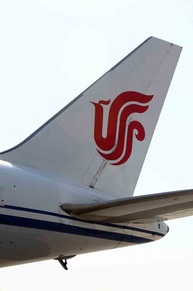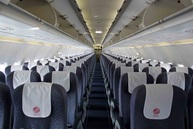|
Malaysia Airlines is the national flag carrier of Malaysia and is the largest airline in Malaysia based on fleet size, international destinations and international flights. The airline serves 60 destinations, both international and domestic. It is among the top 20 airlines in the world in terms of passengers carried and is also the top-ranked international cargo airline.
At the time of writing, Malaysia Air operates a fleet of 86 aircraft, including 6 Airbus A380 and 56 state-of-the-art Boeing 737NG aircraft. This was the first time I flew with Malaysia Airlines. I was on the flight from Hong Kong Chep Lap Kok Airport to Kuala Lumpur International Airport on Malaysia Airlines’ Boeing 737-800NG to check out their Economy Class seats! Route: HONG KONG (HKG) to KUALA LUMPUR INTL. AIRPORT (KUL) Departure date and time of flight: 08:45am, August 2015 Flight number: MH79 (ICAO call sign: “Malaysian”) Flight duration: 3h 55m Class: ECONOMY CLASS Aircraft type: BOEING 737-800NG (56 in service) Unit cost of each Boeing 737-800NG: US$72.5 million (2015) Aircraft registration: 9M-MXL (First flight 26th October 2012) Engine Type: Two x CFMI CFM56-7B26 Aircraft Serial Number: 40139 LN: 4246 Frequent flyer programme: Malaysia Airlines' frequent flyer programme is called Enrich by Malaysia Airlines (Enrich). Enrich comprises a variety of airlines, banks, credit-card issuers, hotels and retailers around the world. Seat configuration for this aircraft: Business Class: 16 angle-flat seats in a 2-2 configuration Economy Class: 150 seats in a 3-3 configuration Punctuality of the flight: Departed bang on time, and landed 20 minutes ahead of schedule. Was greeted with a final view of Shenzhen as we departed Hong Kong – quite a sad moment as the city means so much to me and I will no doubt miss living there. Any baggage issues: No issues regarding the baggage. For Economy Class, Malaysia Airlines have a checked baggage allowance of 23 kg total for all routes excluding transatlantic routes, and upto 40kg for Business Class. All routes have a carry-on allowance of one piece not exceeding 7 kg (50x37x25 cm). Click here to see more details Comments on the check-in staff and flight route: It is always a pleasure when flying from Hong Kong. The previous night I had stayed at the Hong Kong Regal Airport, voted one of the best airport’s in the world. During approach into Kuala Lumpur, passengers have to contend with turbulence due to the localised hot air rising from the canopy. Kuala Lumpur airport is surrounded by lush green forests. We had a few bumps, and suddenly most of the passengers went “Ohhhh”. Considering that Malaysia Airlines unfortunately experienced two crashes in 2014, it was quite a tense moment indeed, where you think “Oh dear lord, I hope not this time!” I honestly thought that the turbulence was the cause of the sudden smoothing of the approach as their planes cross into the airport. Comments regarding the pre-flight service: Upon embarking the aircraft, passengers in Business Class and Economy Class were offered welcome drinks consisting of fresh orange juice, fresh apple juice, mineral water (champagne, wines in Business Class only). The cabin crew are truly one of the best trained I have met on any other airline. Customer comes first and Malaysia Airlines truly define the meaning of a five-star service. Comments regarding the pre-meal service: Passengers in Economy Class were offered a packet of fresh pretzels packed in Malaysia Airlines branded packets, and a choice of drinks from the trolley service. The cabin crew were polite and friendly. Even though this flight was full, the cabin crew paid full attention each and every customer instead of just passing the meal to passengers like they do on some other airlines. I just resorted to drinking plenty of bottled water. Though they may sound very tempting, however, alcohol and coffee are not good to drink during a flight as it just dehydrates you. Water is the best. Comments regarding the first meal: The meal tray arrived at around 30 minutes after take-off from Hong Kong. There were two options for the main meal:
I opted for the fish with rice and vegetables. The food was fresh, and better than what you get on most other airlines in Economy Class. This is why Malaysia Airlines is different because they provide a fine dining experience in all classes of travel- one that is easily comparable to going to a five-star restaurant. You get what you pay for, and Malaysia Airlines does not fail. Accompanying the main dish was a bowl of freshly cut salad with carrot shredding, tomato, cucumber and shredded lettuce all in one action packed bowl!). It’s ridiculously good to have some crunchy salad to accompany a slightly heavy yet tasty dish as I had. Orange juice and mineral water were provided by Malaysian company Spritzer. For dessert, Malaysia Airlines provided a bowl of sweet sago rice. In Economy Class, Malaysia Air still provides plastic cutlery to the passengers. Comments regarding the after meal drinks and in-flight snacks: Plenty of fresh water, coffee and tea are offered in lovely Malaysia Airlines branded paper cups (that can be recycled) were offered. Comments regarding the second meal: None. There was no second meal. Comments on the in-flight entertainment system: Almost all 737-800s have personal AVOd screens featuring a wide variety of music and audio options. All other 737-800s have standard audio options. Almost all 737-800s have personal AVOD screens for all seats. Business Class has 10.6" screens while Economy Class has 9" screens. All other 737-800s have overhead screens. There is an 110v AC power outlet at every Business Class seat. Comments of professionalism of the cabin crew: The cabin crew were very hospitable, and proud to work for Malaysia Airlines. There was a genuine smile on every crew members face and you could tell that they really enjoyed their job. There was a real sense of teamwork in the cabin. As a customer (or passenger) it is easy to tell if the cabin crew are not getting along with each other (it does happen like any other job!), and on this flight I could see that everyone was in a joyous mood. If there was something I wanted or a question I had, then no one objected to it. Instead, they tried their best to help me as much as they could. The senior purser was just gem of a person. The whole flight experience was like magic, and everything seemed to go smoothly. So, yes the world can be ideal sometimes. Comments on the interior of the aircraft (including seat comfort): Economy class is available on all of Malaysia Airlines' fleet. Seats feature a pitch of 33-34 inches and width of 17-17.25 inches, while the newer fleets such as the Airbus A380, Airbus A330-300 and Boeing 737-800 feature seat pitch of 30-32 inches and width of 17-17.5 inches. On the Boeing 777-200, it has a 6.5" personal TV located behind each seat, and a footrest located below the seat in front, the leased 737-800 has no personal TV but overhead TV's located in the aisles of the plane and feature a seat pitch of 29-30 inches. The new A330-300 as well as the new 737-800 all have the new Select 3000i. In 2010, economy class was voted the World's Best Economy Class at the 2010 World Airline Awards by Skytrax. Seatback meal tray tables are available except in the front row which is an 'in-arm' table. Individual overhead reading lights. Seat cover: Woolen. Headrest cover: Paper disposable. Seats are arranged as 3-3. Malaysia Airlines logo and livery: The original corporate logo was designed by Dato' Johan Ariff, and was introduced on 15 October 1987, retaining the essence of the moon kite, with a sheared swept-back look. Along with the new corporate logo, a new type style - MALAYSIA, was created. It is italicised to slant parallel with the logo to accentuate speed as well as direction. Within this corporate typestyle, the letters MAS bear red clippings to denote the initials of the statutory name of the airline, Malaysian Airline System (MAS), and were added after the original design was rejected by former Prime Minister Mahathir Mohammad. The introduction of blue to the original red logo has national significance. The red and blue divides equally in the middle to denote equilibrium. On 8 March 2012, Malaysia Airlines unveiled a new logo featuring an all-blue moon kite and livery for its Airbus A380 fleet. Months later, the corporate logo of red and blue was refreshed. The new moon kite logo faces from left to right, as it did in the original 1971 logo, and its tails have been extended. The wordmark has also been modernised with a new typeface and the word "airlines" is now presented in lowercase. On 1st September 2015, Malaysia Airlines rebranded as Malaysia Airlines Berhad but for the time being remained to use the same logo and branding Overall rating 1-10 (worst-best): 10 Comments are closed.
|
About Airline PRThis is a special section on Airline Branding, and Airline Public Relations written by me on all the flights I have been fortunate enough to have been on. These are not records taken from somewhere else, but are actual flights I have been on. Most of the flight trips are officially sponsored by the airline companies in order to promote their certain routes, and aircraft. Airline promotion and PR related work in the aviation industry is one of my expertise. Watch exclusive videos below taken in the cockpit of a Boeing 777-300ER in-flight over Chinese Airspace.
Special thanks goes to Turkish Airlines B777-300ER Cockpit Video 1B777-300ER Cockpit Video 2Archives
March 2024
Airlines Reviewed
All
Proud media partner of QATAR AIRWAYS |





























